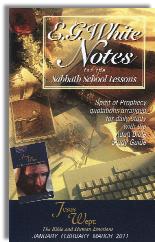|
||||||||||||||
Commentary on "Emotions"
Day 5: Wednesday, December 29, 2010 - Jesus' Emotional Manifestations: Part 2
Overview
Today’s lesson continues yesterday’s look at Jesus’ “emotional manifestations”. It looks at Jesus weeping over Jerusalem and quotes Ellen White’s observations about this event. The lesson then asks us to identify other painful emotions Jesus felt and refers to Isaiah 53 where it is prophesied that the Messiah would be a man of sorrows. The lesson ends with a reference to Hebrews 4:15 where Jesus is described as a high priest who can sympathize with our feelings, and the lessons asks the question, “How can the message of this text bring us into a closer bond with Jesus, especially in times of suffering?”
Observations
The author refers to Ellen White’s comments in Spirit of Prophecy, vol. 3, p. 20, where she says Jesus’ tears over Jerusalem “were the last pleadings of rejected love and compassion.” The point is then made that people usually cry for themselves, but on this occasion and on the occasion of Lazarus’ death, Jesus wept because of deep feelings for others.
In context, Luke 19:41-44 (the text used to introduce the lesson) records Jesus’ judgment upon Jerusalem. He cried because of His own people’s rejection of God’s provision for them. They rejected the One who fulfilled the promises God gave them, and He issued the words of judgment they would experience as a consequence of their rejection. They would be invaded and their city torn down. They themselves would be scattered and destroyed—all because they “did not know the time of your visitation.”
Jesus’ weeping was no sentimental expression of sorrow over rejection. He was sorrowing over the judgment they would face; His feelings were not the point. Neither are they the point of his agony in the garden (Matt. 26:37, 38), of His anger at the hardness of heart shown by the Jews when He healed a man’s withered hand on the Sabbath (Mark 3:4-5), when the Pharisees demanded a sign (Mark 8:7), when He wept at Lazarus’ death (John 11:28-38; or when He overturned the tables of the moneychangers in the temple (Mark 11:15,16).
In each of the above situations, Jesus’ feelings were not the message. Jesus was demonstrating His authority over death, over disease, over the Sabbath, and over sin. His agony in the garden was the agony of facing the reality that He was becoming sin for us. Yet He became sin for us because only He had the authority as our Creator to take it onto Himself. His anger at the Pharisees in the synagogue was His anger at their unbelief, their refusal to see that He was the Messiah who was systematically fulfilling every prophecy made of the Messiah. Moreover, He was demonstrating that their protection of the Sabbath was eclipsing God’s finished work, His provision for all who believe. At Lazarus’ death, Jesus was weeping over the sorrow of those who did not yet know that He was about to destroy death’s power.
His resurrection of Lazarus prefigured His own resurrection a few days later. He drew the attention of Judea to the miracle of Lazarus’ return to life—making it clear that He held the power of life in Himself. He was God—because only God can raise the dead. His sorrow was for the hopeless darkness in which His people were bound. They were by nature objects of wrath (Eph 2:3), and they did not know that He was about to open a new, living way to the Father through His own body (Heb. 10:20).
To be sure, Jesus’ emotions do demonstrate to us that He feels as we feel, that He experienced the full range of human feelings, but His emotions are not the thing we are to learn to emulate. Emotions are part of our human condition.
Conclusion
- We do not learn to manage our emotions by contemplating Jesus’ emotional reactions.
- We learn to trust God in spite of our emotions by submitting to the Lord Jesus and allowing Him through His Spirit to make us new, to give us the mind of Christ (1 Cor 2:16).
- Jesus’ emotions reflected His feelings, but the point of those moments was His own authority over all the physical world as well as spiritual reality. He has authority over sin and death and disease.
- What we are to learn from these events in Jesus’ life is that He is God—the One sent to break the power of all that holds us in the domain of darkness.
- We are to trust Him and submit to Him—not to emulate Him.
- Jesus did not come to show us how to live; He came to give us His life and to make us new.
Copyright 2010 BibleStudiesForAdventists.com. All rights reserved. Revised December 27, 2010. This website is published by Life Assurance Ministries, Glendale, Arizona, USA, the publisher of Proclamation! Magazine. Contact email: BibleStudiesForAdventists@gmail.com.
The Sabbath School Bible Study Guide and the corresponding E.G. White Notes are published by Pacific Press Publishing Association, which is owned and operated by the Seventh-day Adventist church. The current quarter's editions are pictured above.
Official Adventist Resources
Standard Edition Study Guide Week 1
Teacher's Edition Study Guide Week 1
Easy Reading Edition Study Guide Wk 1
Search the Complete Published Ellen G. White Writings


